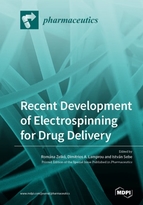Recent Development of Electrospinning for Drug Delivery
A special issue of Pharmaceutics (ISSN 1999-4923).
Deadline for manuscript submissions: closed (31 August 2019) | Viewed by 74444
Special Issue Editors
Interests: polymeric delivery systems; physical ageing of polymers; solid-state characterisation; functionality-related characteristics of polymeric delivery systems; microstructural characterisation of dosage forms; stability tracking of solid dosage forms; regulatory aspects of dosage forms
Special Issues, Collections and Topics in MDPI journals
Interests: 3D printing; bioprinting; drug delivery; electrospinning; medical devices; pharmaceutics; microfluidics
Special Issues, Collections and Topics in MDPI journals
Interests: electrospinning; high-speed rotary spinning; solid-state characterisation; industrial feasibility of spinning techniques; pharmaceutical industrial drug development
Special Issues, Collections and Topics in MDPI journals
Special Issue Information
Dear Colleagues,
Several promising techniques have been developed to overcome the poor solubility and/or membrane permeability properties of new drug candidates, including different fiber formation methods. Electrospinning is one of the most commonly used spinning techniques for fiber formation induced by the high voltage applied to the drug-loaded solution. With modifying the characteristics of the solution and the spinning parameters, the functionality-related properties of the formulated fibers can be finely tuned. The fiber properties (high specific surface area, porosity, the possibility of controlling the crystalline-amorphous phase transitions of the loaded drugs) enable the improved rate and extent of solubility, causing a rapid onset of absorption. However, the enhanced molecular mobility of the amorphous drugs embedded into the fibers is responsible for their physical–chemical instability.
This Special Issue will address new developments in the area of electrospun nanofibers for drug delivery applications, covering recent advantages and future directions on electrospun fiber formulations and scalability. Moreover, it serves to highlight and capture the contemporary progress of electrospinning techniques (solution and melt) with particular attention to the industrial feasibility of developing pharmaceutical dosage forms. We invite articles on all aspects of drug-loaded fibrous dosage forms focusing on the processability, structures and functions, and stability issues based on regulatory requirements. Original research papers and review articles are welcome.
Prof. Dr. Romána Zelkó
Prof. Dr. Dimitrios A. Lamprou
Dr. István Sebe
Guest Editors
Manuscript Submission Information
Manuscripts should be submitted online at www.mdpi.com by registering and logging in to this website. Once you are registered, click here to go to the submission form. Manuscripts can be submitted until the deadline. All submissions that pass pre-check are peer-reviewed. Accepted papers will be published continuously in the journal (as soon as accepted) and will be listed together on the special issue website. Research articles, review articles as well as short communications are invited. For planned papers, a title and short abstract (about 100 words) can be sent to the Editorial Office for announcement on this website.
Submitted manuscripts should not have been published previously, nor be under consideration for publication elsewhere (except conference proceedings papers). All manuscripts are thoroughly refereed through a single-blind peer-review process. A guide for authors and other relevant information for submission of manuscripts is available on the Instructions for Authors page. Pharmaceutics is an international peer-reviewed open access monthly journal published by MDPI.
Please visit the Instructions for Authors page before submitting a manuscript. The Article Processing Charge (APC) for publication in this open access journal is 2900 CHF (Swiss Francs). Submitted papers should be well formatted and use good English. Authors may use MDPI's English editing service prior to publication or during author revisions.
Keywords
- electrospinning
- various electrospinning techniques (combined fiber formation methods)
- industrial feasibility
- scale-up possibilities
- drug delivery systems
- electrospun scaffolds
- nanofibers
- diversity of electrospun fibers
- potential drug candidates for nanofibrous dosage forms
- tunable fibrous drug delivery
- stability of drug-loaded fibers and dosage forms









